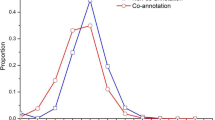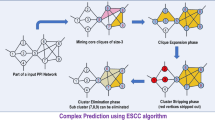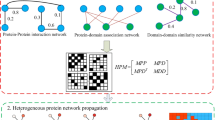Abstract
It is known that the observed PPI network is incomplete with low coverage and high rate of false positives and false negatives. Computational approach is likely to be overwhelmed by the high level of noises and incompleteness if relying on local topological information.We propose a global voting (GV) model to predict protein function by exploiting the entire topology of the network. GV consistently assigns function to unannotated proteins through a global voting procedure in which all of the annotated proteins participate. It assigns a list of function candidates to a target protein with each attached a probability score. The probability indicates the confidence level of the potential function assignment. We apply GV model to a yeast PPI network and test the robustness of the model against noise by random insertion and deletion of true PPIs. The results demonstrate that GV model can robustly infer the function of the proteins.
Access this chapter
Tax calculation will be finalised at checkout
Purchases are for personal use only
Preview
Unable to display preview. Download preview PDF.
Similar content being viewed by others
References
Altschul, S.F., Madden, T.L., Schaffer, A.A., Zhang, J., Zhang, Z., Miller, W., Lipman, D.J.: Gapped blast and psi-blast: a new generation of protein data base search programs. Nucl. Acids Res. 25, 3389–3402 (1997)
Chen, X., Liu, M.: Prediction of protein-protein interactions using random decision forest framework. Bioinformatics 21, 4394–4400 (2005)
Chua, H.N., Sung, W.K., Wong, L.: Exploiting indirect neighbors and topological weight to predict protein function from protein-protein interactions. Bioinformatics 22, 1623–1630 (2006)
Deane, C.M., Salwinski, L., Xenarios, O., Eisenberg, D.: Protein interactions: two methods for assessment of the reliability of high through put observations. Molecular & Cellular Proteomics: MCP 1, 349–356 (2002)
Deng, M., Zhang, K., Mehta, S., Chen, T., Sun, F.: Prediction of protein function using protein-protein interaction data. Journal of Computational Biology 10, 947–960 (2003)
Deng, M., Tu, Z., Sun, F., Chen, T.: Mapping gene ontology to proteins based on protein C protein interaction data. Bioinformatics 20(6), 895–902 (2004)
Edwards, A., Kus, B., Jansen, R., Greenbaum, D., Greenblatt, J., et al.: Bridging structural biology and genomics: assessing protein interaction data with known complexes. Trends in Genetics 18, 529–536 (2002)
Freschi, V.: Protein function prediction from interaction networks using a random walk ranking algorithm. In: Proceedings of the 7th IEEE International Conference on Bioinformatics and Bioengineering, BIBE 2007, pp. 42–48 (2007)
Giot, L., Bader, J., Brouwer, C., Chaudhuri, A., Kuang, B., et al.: A protein interaction map of drosophila melanogaster. Science 302, 1727–1736 (2003)
Hishigaki, H., Nakai, K., Ono, T., Tanigami, A., Takagi, T.: Assessment of prediction accuracy of protein function from protein-protein interaction data. Yeast 18, 523–531 (2001)
Hu, P., Bader, G., Wigle, D.A., Emili, A.: Computational prediction of cancer-gene function. Nature Reviews Cancer 7, 23–34 (2007)
Ito, T., Tashiro, K., Muta, S., Ozawa, R., Chiba, T., et al.: Toward a protein-protein interaction map of the budding yeast: A comprehensive system to examine two-hybrid interactions in all possible combinations between the yeast proteins. Proceedings of the National Academy of Sciences of the United States of America 97, 1143–1147 (2000)
Karaoz, U., Murali, T., Letovsky, S., Zheng, Y., Ding, C.: Whole-genome annotation by using evidence integration in functional-linkage networks. Proceedings of the National Academy of Sciences of the United States of America 101, 2888–2893 (2004)
Kourmpetis, Y.A.I., van Dijk, A.D.J., Bink, M.C.A.M., van Ham, R.C.H.J., ter Braak, C.J.F.: Bayesian markov random field analysis for protein function prediction based on network data. PLoS One 5 (2010)
Krogan, N., Cagney, G., Yu, H., Zhong, G., Guo, X., et al.: Global landscape of protein complexes in the yeast saccharomyces cerevisiae. Nature 440, 637–643 (2006)
Kuchaiev, O., Rasajski, M., Higham, D., Przulj, N.: Geometric de-noising of protein-protein interaction networks. Plos Computational Biology 5 (2009)
Lafon, S., Keller, Y., Coifman, R.: Data fusion and multi cue data matching by diffusion maps. IEEE Transactions on Pattern Analysis and Machine Intelligence 28, 1784–1797 (2006)
Lerman, G., Shakhnovich, B.: Defining functional distance using manifold embeddings of gene ontology annotations. Proceedings of the National Academy of Sciences of the United States of America 104, 11334–11339 (2007)
Mewes, H.W., Frishman, D., Guldener, U., Mannhaupt, G., Mayer, K., Mokrejs, M., Morgenstern, B., Munsterkotter, M., Rudd, S., Weil, B.: Mips: a database for genomes and protein sequences. Nucleic Acid Research 30, 31–34 (2002)
Nabieva, E., Jim, K., Agarwal, A., Chazelle, B., Singh, M.: Whole proteome prediction of protein function via graph-theoretic analysis of interaction maps. Bioinformatics 21, i302–i310 (2005)
Pawson, T., Gish, G., Nash, P.: Sh2 domains, interaction modules and cellular wiring. Trends in Cell Biology 11, 504–511 (2001)
Provost, F.J., Fawcett, T.: Analysis and visualization of classier performance: Comparison under imprecise class and cost distributions. In: KDD, pp. 43–48 (1997)
Punta, M., Ofran, Y.: The rough guide to insilico function prediction, orhow to use sequence and structure information to predict protein function. PLoS Computational Biology 4 (2008)
Rahmani, H., Blockeel, H., Bender, A.: Predicting the functions of proteins in ppi networks from global information. JMLR: Workshop and Conference. In: Proceedings, International Workshop on Machine Learning in Systems Biology, Ljubljana, Slovenia, vol. 8, pp. 82–97 (2010)
Schwikowski, B., Uetz, P., Field, S.: A network of protein-protein interactions in yeast. Nature Biotechnology 18, 1257–1261 (2000)
Sharan, R., Ulitsky, I., Shamir, R.: Network-based prediction of protein function. Molecular Systems Biology 3, 1–13 (2007)
Shoemaker, B.A., Panchenko, A.R.: Deciphering protein c protein interactions. part i. experimental techniques and databases. PLoS Comput. Biol. 3 (2007a)
Shoemaker, B.A., Panchenko, A.R.: Deciphering protein c protein interactions. part ii. computational methods to predict protein and domain interaction partners. PLoS Comput. Biol. 3 (2007b)
Stelzl, U., Worm, U., Lalowski, M., Haenig, C., Brembeck, F., et al.: A human protein-protein interaction network: A resource for annotating the proteome. Cell 122, 957–968 (2005)
Uetz, P., Giot, L., Cagney, G., Mansfield, T., Judson, R., et al.: A comprehensive analysis of protein-protein interactions in saccharomyces cerevisiae. Nature 403, 623–627 (2000)
Vazquez, A., Flammini, A., Maritan, A., Vespignani, A.: Global protein function prediction from protein-protein interaction networks. Nature Biotechnology 21, 697–700 (2003)
Von Mering, C., Krause, R., Snel, B., Cornell, M., Oliver, S., et al.: Comparative assessment of large-scale data sets of protein-protein interactions. Nature 417, 399–403 (2002)
Author information
Authors and Affiliations
Editor information
Editors and Affiliations
Rights and permissions
Copyright information
© 2014 Springer International Publishing Switzerland
About this paper
Cite this paper
Fang, Y., Sun, M., Dai, G., Ramani, K. (2014). Global Voting Model for Protein Function Prediction from Protein-Protein Interaction Networks. In: Huang, DS., Han, K., Gromiha, M. (eds) Intelligent Computing in Bioinformatics. ICIC 2014. Lecture Notes in Computer Science(), vol 8590. Springer, Cham. https://doi.org/10.1007/978-3-319-09330-7_54
Download citation
DOI: https://doi.org/10.1007/978-3-319-09330-7_54
Publisher Name: Springer, Cham
Print ISBN: 978-3-319-09329-1
Online ISBN: 978-3-319-09330-7
eBook Packages: Computer ScienceComputer Science (R0)




